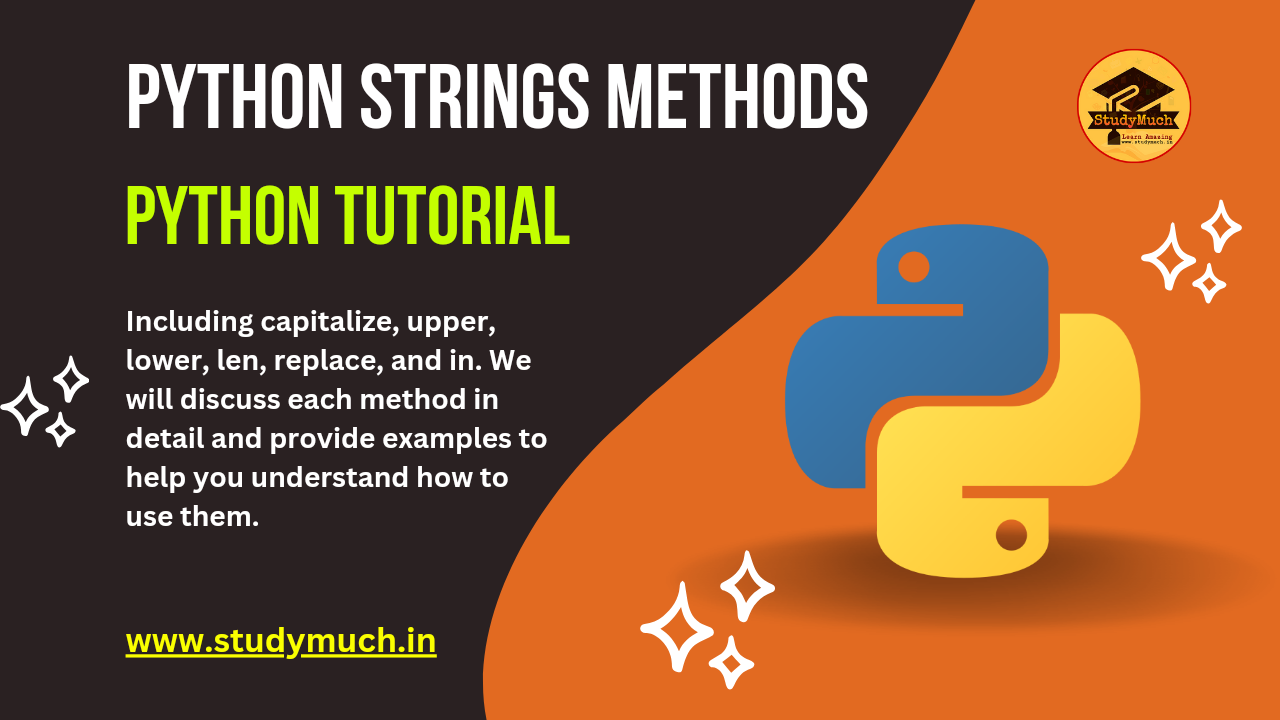Python String Methods

Python String Methods: A Comprehensive Guide
Strings are an essential data type in Python, and Python provides a wide range of built-in string methods to effectively manipulate and work with them. In this blog post, we will explore some of the most commonly used Python String Methods, including capitalize, upper, lower, len, replace, and in. We will discuss each method in detail and provide examples to help you understand how to use them.
Capitalize String; (capitalize())
The capitalize() method capitalizes the first character of a string while converting all other characters to lowercase. This method is useful when you want to ensure that the first letter of a string is capitalized.
Note: It does not modify the original string.
Example:
text = "hello, world!" capitalized_text = text.capitalize() print(capitalized_text) # Output: "Hello, world!"

Convert to Upper Case; (upper())
The upper() method converts all characters in a string to uppercase. It’s often used when you want to standardize the case of a string for comparison or display purposes.
Note: It does not modify the original string.
Example:
text = "hello, world!" uppercase_text = text.upper() print(uppercase_text) # Output: "HELLO, WORLD!"
Convert to Lower Case; (lower())
The lower() method converts all characters in a string to lowercase. It’s helpful when you want to ensure that a string is in lowercase for consistency.
Note: It does not modify the original string.
Example:
text = "Hello, World!" lowercase_text = text.lower() print(lowercase_text) # Output: "hello, world!"
Get the Length of a String; (len())
The len() function is not a string method, but it is often used to get the length (number of characters) of a string. This is a built-in python function. This function returns the length of a string, it takes one parameter, string.
Example:
text = "Python is amazing!" length = len(text) print(length) # Output: 18
Replacing Parts of String; (replace())
The replace() method allows you to replace all occurrences of a substring within a string with another substring. This can be handy for text manipulation and data cleaning.
Note: It does not modify the original string.
Syntax;
string.replace(old, new)
- old – the substring to be replaced, it is case-sensitive.
- new – the new substring that will replace the old substring.
Programming Example:
text = "I like apples, but I don't like bananas." new_text = text.replace("apples", "oranges") print(new_text) # Output: "I like oranges, but I don't like bananas."
Above example, the replace() function replace all occurrences of the old substring with the new substring.
Check if a Value is Present in a String; (in)
The in operator is used to check if a specific substring exists within a string. It returns True if the substring is found and False otherwise.
Note: The evaluation is case-sensitive.
Example:
text = "Python is a versatile programming language." substring = "versatile" if substring in text: print(f"'{substring}' is present in the string.") # Output: "'versatile' is present in the string."
These are some of the basic string methods in Python, but there are many more available to meet different string manipulation needs. Experiment with these methods and explore the Python documentation to discover additional string methods and their capabilities.
Remember that string methods do not modify the original string, but return a new modified string. If you want to update the original string, you should reassign the result to the variable holding the original string.
Conclusion;
Finally, it is important to understand and master string methods for effective string manipulation in Python. They allow you to easily transform and manipulate text, making them a valuable tool in your programming arsenal. I hope you have understood these Python String Methods, but if you have any doubt regarding this tutorial, you can ask in the comment section.
Learn More;
- Learn Python Number Methods.
- Draw Indian Flag with Python Code.
- Learn Python Data Types.
- Learn Tutorial of C Language.
- Learn Tutorial of HTML and CSS.



0 Comments